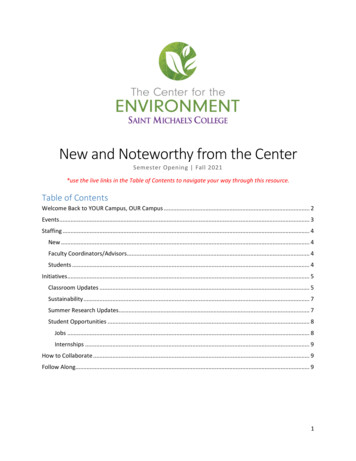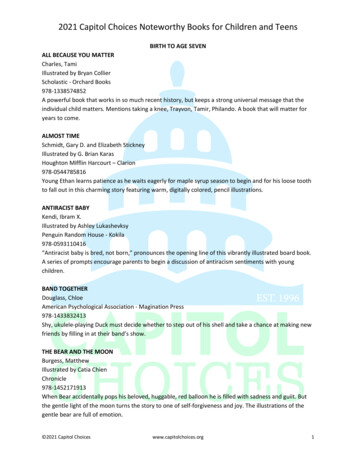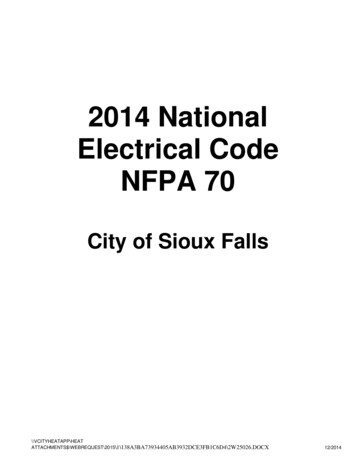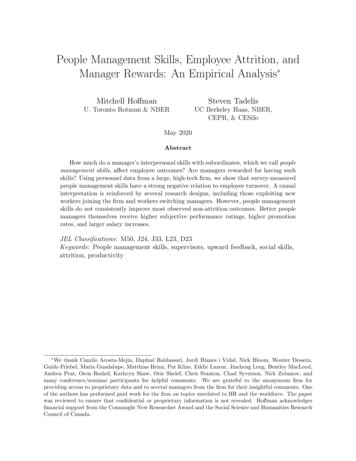
Transcription
New and Noteworthy from the CenterSemester Opening Fall 2021*use the live links in the Table of Contents to navigate your way through this resource.Table of ContentsWelcome Back to YOUR Campus, OUR Campus . 2Events . 3Staffing . 4New . 4Faculty Coordinators/Advisors. 4Students . 4Initiatives . 5Classroom Updates . 5Sustainability . 7Summer Research Updates . 7Student Opportunities . 8Jobs . 8Internships . 9How to Collaborate . 9Follow Along. 91
Welcome Back to YOUR Campus, OUR CampusWhile challenging, our very warm and rainy summer has nourished our outdoor classrooms so deeply. It is myhope that they will in turn nourish and replenish you all as you return for another school year after our year ofdeep challenges.The Center continues to evolve and collaborate across campus and our community with great success. Mostrecently, we have moved to St. Edmund’s Hall, room 119 to bring together all of our programs and create a spaceto gather and explore and develop a library of resources to support cross-sector and interdisciplinary teaching,learning, knowing and doing. Come visit!Late Spring and into early Summer, under Prof. McCabe’s guidance, we conserved the most of the Natural Areaand the funds received from the conservation have fueled an endowment for the site and some of the work theCenter will do in coming years. This work allows us to partner with other state and national agencies. It alsoallows us to pursue the development of a covered classroom space this spring in the Natural Area.Our CSA (Community Supported Agriculture) program through our Farm supported 40 members for 18 weeks overthe spring and summer and is set to resume the 2nd week in September for the fall. There are 10 more CSA slotsavailable for students this fall. Thanks to generous Farm patronsand CSA members, we’ve been able to gift 4 CSA memberships toour campus community. And, the farm isn’t a farm in the summerwithout Salad Days or our regular volunteer days to makeeverything fun and centered on our community.Finally, we began our dedicated focus on deliberately evaluatingour programming, resources, and outreach materials with the goalof making them more diverse, equitable, and inclusive to ensurethat our environmental work is also just work for our BIPoCcommunity members. Our summer intern, Juana Lopez, lead thiswork with the consultation of Sarah Childs, director of CMAS (Center for Multicultural Affairs), as well as her peersfrom the MLK Society and the Diversity Coalition. This work and more will continue this fall with the Racial JusticeTask Force and support our First Year Seminar Program as students and faculty explore the common read,Braiding Sweetgrass by Robin Wall Kimmerer. Kimmerer asks and coaches us in her text to not only explore andidentify the ecological components of the land, but to develop a relationship with the land. This approach is onewoven into the fabric of the culture of our indigenous ancestors and carried forth byour Elders. Kimmerer leads us to investigate this relationship through the gifts ofasters, goldenrod, strawberries, squash, salamanders, algae and sweetgrass. Iencourage you to begin your own investigations through the Natural Area, TeachingGardens, and the Farm to make a physical connection with most of these gifts. All butsweetgrass can be found in these classrooms. When you encounter them, considerKimmerer’s rules for “taking”, consider an Honorable Harvest.1.2.3.4.5.6.7.8.9.Don’t just grab & never take the first, this ensures you are never taking the last.Ask permissionThen, listen for the answerTake only what you needMinimize harm in doing soUse everything you takeBe grateful; give thanksShare with othersReciprocate the gifts(Adapted from Bioneers 2014 Keynote Address: Mishkos Kenomagwen: The Teachings of Grass https://www.youtube.com/watch?v cumEQcRMY3c)2
Kimmerer speaks of these gifts from the land, she speaks of a reciprocal relationship rather than one ofconsumerism. Our first year students will grapple with these ideas in their First Year Seminars, however, this iswhere I ask each of us, employees, students and visitors alike, to consider this not SMC’s campus, but ourcampus. I ask you to think about how you are a steward in your day to day activities of our resources and thereciprocal relationship of us to the resources. I ask you to consider contemplation and intention as participantsand collaborators rather than consumers of place.Join me in welcoming the Class of 2025 to our community, and join me this year in exploring the interlockingrelationships of a small community of people and place!Peace,KristynDirector, Center for the EnvironmentEvents Move In to YOUR Campus – August 27th, 28th, & 29thNursery Mulching with Green Up & Prof. Stanger on August 31st from 3:30-5:30.Self-serve Farm Stand, Every Monday to Friday, 9am – 6pm until mid-October, STE 119, cash,check & Knight Card for paymentOpen Air Farm Stand – Thursdays beginning 9/2 at 1:30-5:15, outside Café Cheray, Rain location,St. Ed’s LobbySalad Day, Tuesday 9/7, 11:30-1:00 on farm.Open Farm Fridays with OVE – every Friday beginning 9/10, 2:00-5:00pmClub Fair on September 11th from 1-4pm to join Green Up, OVE, or any of the other programs oncampus!Family & Alumni Weekend, 9/17 & 9/18a. Friday 3:00-5:00 Special Farm Stand in Dionb. Saturday 9:30-11:30 Special Service Day on FarmBraiding Sweetgrass by Robin Wall Kimmerer, Virtual Speaking Event, 9/27 at 7pmBCorp Event – An alumni panel discussion on BCorps. B The Change You Want To See In TheWorld: Working for B Corps - Wednesday October 6th, 5pm, Roy Room3
StaffingNewWelcome to Christine Gall!Christine comes to St. Michael’s from Kids Gardening in Burlington,most recently. Christine has served farms in Maine and Vermont overthe last 10 years with a strong mix of farm-based education anddiversified vegetable farm management. She has worked with schoolfood programs in Burlington and is eager to build the “food” part ofour Farm & Food Program here at SMC. Christine has recentlycompleted her Master of Science from Prescott College in SustainableFood Systems with a concentration in sustainable diets andbiodiversity. Her capstone project was to write a curriculum for K-5classroom cooking programs and was the inspiration for her thesis:Supporting Farm to School Initiatives in VT through the Design of K-5Classroom Cooking Resource. Please welcome Christine to the role of Assistant Manager, Farm & FoodProgram!Faculty Coordinators/Advisors Mark Lubkowitz & Valerie Bang-Jensen, Faculty Advisors for the Teaching Gardens; Professors ofBiology & Education, respectivelyDeclan McCabe, Faculty Coordinator for the Natural Area; Professor of BiologyTrevien Stanger, Faculty Advisor for Green Up; Instructor of Environmental StudiesKristyn Achilich, Director of the Center for the Environment and the Farm & Food Program;Instructor of EducationStudents Emily Krumm, Education & Outreach Coordinator for the Farm & FoodProgramJess Edmonds, Crop & Field Coordinator for the Farm & Food ProgramGina Atkinson, Farm Team MemberMatt Leveroni, Farm Team MemberSam Belanger, Data Systems Coordinator for the Center for theEnvironmentSarah Newton, Lead Steward for the Teaching GardensElizabeth Crotty, Lead Steward for the Natural Area Anna Beach, Shannon Harty, Samantha Callaway, Tallis Diehn & Tim Strzepa, Leadership Teamfor Green Up Anna Beach, Shannon Harty, & Sam Belanger, Leadership Team for Outdoor Volunteer Effortsthrough MOVE4
InitiativesClassroom UpdatesFarmThe Farm has harvested just over 2000 pounds of this spring and summer. We have over 50 differentcrops growing on our farm and have harvested 29 of those crops to date. The summer team of 6students stewarded the farm to this point and served our 40 CSA members and self-serve farm standover the summer. We hosted 2 salad days and will have a 3rd next week, September 7th. This fall, lookforward to:a. Farm Stand – outside of Café Cheray every Thursday from 1:30-5:15.b. Self-serve Farm Stand – every Monday through Friday 9am to 6pm in the Center’s office, STE119.c. CSA – we have 10 more spots for students. You can register here, first come first serve.d. Open Farm Days – Friday’s, 2pm to 5pm, come straight to farm or meet at MOVE to walk downtogether. This event happens on the farm, but is lead through MOVE’s Outdoor VolunteerEfforts program.e. Final Salad Day – Tuesday, September 7th, 11:30-1:00f. Alumni & Family Weekendi. Friday Special Farm Stand 3:00-5:00pm at the Activities Fair in Dionii. Saturday Special Service Day on Farm 9:30-11:30Teaching GardensThe Teaching Gardens are in their prime this time of year. Use them for group meetings, classes, acasual walk & read. A beautiful series of book walks will be up this Fall!Help celebrate the 10th anniversary of the Word Garden in October! There will be a haiku contest,refreshments, and the placing of 35 new stones in memory of Instructor Emeritus of English, WillMarquess.Natural AreaTrails and Trees: Summer storms brought down seven trees that temporarily blocked trails in theNatural Area. Like all organisms, trees have a life cycle, and those cycles vary. In the lower floodplain,box elders are common and they have shorter lifecycles than many tree. So it is not surprising to findthat most of the fallen trees in that area were box elders. Some of the fallen were easily handled usinghand saws and loppers. But many of the trees required some subtle chainsaw surgery to reopen thetrails and we are grateful to Ryan Longe and Scott O’Brien from Facilities for tackling those tasks. Thefallen trunks were tossed out into the former field to continue to provide essential habitat for insectsand the birds such as woodpeckers that critically depend upon the insects found in rotting wood.Profs. Stanger and McCabe spent some time in early summer weed whacking around the trees andshrubs planted by students this spring. The greater majority of trees and shrubs looked healthy andwere leafing out. Weed whacking is not strictly speaking necessary, but it can give newly planted trees afighting chance, particularly when they are planted among reed canary grass that can grow to 8 feet talland shade out the growing trees. But the trees are in it for the long haul and will eventually produce tall5
canopies that will shade out the invasive grass. We planted them at high density in anticipation thatsome would not make it, but enough will survive to found a more diverse community than themonoculture they are replacing.Finally, Jeff Vincent has been busy keeping the herbaceous vegetation off the trails. In the early part ofsummer he used his personal riding mower to keep the trails open, but the terrain proved too rough fora machine designed for maintaining a smooth lawn and it died during one of his mowing runs. Morerecently, Jeff has been using a college-owned machine that is better suited to the task and his effortshave paid off. We have once again, four miles of open trail ready and waiting for returning students.Beavers and Flooding: The main trail leading between the compost and the floodplain has been floodedankle deep for most of the summer. The rainy weather is only part of the explanation. Beavers havemoved in downstream of the low point in the road and their dams are backing the water up to the pointof flooding our entrance to the floodplain. Beavers are not new to the area and we have certainly seenevidence of their work for many years. Ryan Crehan from US Fish and Wildlife has been working on oursite and has notched seven beaver dams downstream of our trail in an attempt to reduce some of theirimpact on our ability to use the trail. This work happened this week and we will see if it is effective inlowering the water level. I guess it is not called a “floodplain” for nothing.Earthwork and Invasives: Work on blocking a culvert that was part of the Natural Area’s agriculturallegacy will commence shortly. The trail intersection below the compost will be temporally blocked as thecontractor moves earth to plug the drain and raise the old road bed. This work is intended to increasethe hydroperiod, or the length of time that standing water persists in the wetland just east of thetrail. This wetland has historically been artificially drained to make more of the site accessible foragriculture. Under the terms of our new conservation easement, agriculture is in our past, and ourcollaborators from the Natural Resources Conservation Service are managing projects like this to restorewetland function on site.An additional part of this work will be to start controlling some of the invasive species that have decidedto make our land their home. This work will also begin shortly is designed to minimize impact onpollinator species.New Signs: We intend to install directional signs at Natural Area trail intersections. Because the areahas the potential to contain Native American artefacts, we sought permission for this work. NRCS senttheir archeologist out to the site and he graciously dug the holes we needed, inspecting the soil as hewent. No artefacts were found and so we can proceed with sign posting in the coming semester. Wepurchased the posts and also the plastic laminate needed to add arrows, trail names etc. These signsshould be in place by mid semester.This Fall, stay tuned for community engaged projects in the Nursery & Natural Area with Green Up &Profs. Stanger & McCabe as well as our Natural Area Stewards.6
SustainabilitySTARS Rating – After a lot of hard work by Prof. Karen Talentino and theEcoReps as well as a number of Sustainable Campus team members thisspring, St. Michael’s has once again earned our Silver Rating through theAASHE STARS program. This is a testament of our efforts coordinatingsustainable education, outreach, and practice here at the college. Our work inthe Natural Area, Bee Campus, Farm, Green Up, Print & Mail, and in manyacademic departments contributes to this rating. Read more about this workhere.We have many resources on campus to support our employees in makingsustainable choices. Check out the brochure here. Many of these are alsoavailable to our students.Finally, here are a few tips to help you on your own stewardship path livingand/or working here on campus.Summer Research UpdatesMeghan GeouqueMeghan brought together her two majors, Environmental Studies andPhilosophy, and explored environmental movements through MartinHeidegger’s work. Heidegger, a German philosopher of phenomenology andexistentialism, allowed Meghan to explore the changing human relationshipwith nature. The goal is to contribute intellectual and contextual work tosustainable development now and in the future. She brought her questionsand investigation to the Farm and Farm Team this summer.“My time on the farm not only allowed me to visualize a practical applicationof philosophy, but also brought an even deeper meaning to my project andits connection to our community.”Meghan is planning to submit her work to this undergraduate journal, Cura Terra:https://gucuraterra.org/. She will also share her work with Prof. L’Hote’s intro philosophy courses and,in that way, introduce her peers to environmental philosophy.Read more about Meghan’s work, written by Laura Hardin ’22, here.7
Cailey ComiskeyCailey conducted field research this past summer at the Elizabeth Mine inStrafford, VT. The Elizabeth Mine opened in the middle part of the 19thcentury and closed in 1958. It was added to the EPA list of NationalPriorities in 2001 because of the high levels of metals emanating from themine site. Cailey took soil and water samples from the mine and theadjacent environment. These samples were analyzed in our Chemistry labfor heavy metals using our Inductively Couple Plasma Optical EmissionSpectrometer (ICP-OES). Her results show levels of contamination in severalmetals that remain above safe levels of exposure for humans and wildlife.Picture 1: One of the point sources of pollution from the Elizabeth Mine. This point source is from water overflowing from anabandoned air shaft now filled with rainwater.Picture 2: Sample collection by students in the Ompompanoosuc River next to the Mine.Student OpportunitiesJobsThe Center will be hiring for 3 positions this fall. Postings soon on the Portal, Center’s IG page, thislistserv, and the Daily Digest. Brief descriptions follow. Administrative & Outreach Coordinator – This is an advanced position for a student with abackground in marketing, education, and event coordination. Stewards – these are entry level positions for first year students. They will join an experiencedemployee in each of the two areas below.o 1 in the Teaching Gardenso 1 for the Natural Area8
InternshipsECHO has a few open fall internships posted now. ere might be one that matches a student’s interests or even if the role isn’t directly in line, it could bea great way to get exposure to the museum as a whole.Common Roots www.commonroots.org has reached out often. Carly Guelli had a great experience there.Lots of info on the website.ContactJennifer SuttonInternship CoordinatorCommon Roots(802) 310-4998NASA DEVELOP National Program – a capacity building program for students for the applied sciences.(full flyer here) DEVELOP projects apply Earth observations and remote-sensing technology toapplication areas that highlight NASA Earth observation capabilities relative to environmental issues forenhanced policy and decision making. These areas include: Health & Air Quality Disasters Transportation & Infrastructure Urban Development Water Resources Ecological Forecasting Energy Food Security & AgricultureHow to Collaborate1. Consultation – Reach out to Kristyn (kachilich@smcvt.edu) to set up an initial meeting to brainstormconnections of our work to class themes, resources, events, or activities to plug into or co-develop.2. Guest Speaker – Contact your interested Center-affiliated member or Kristyn to request/coordinatea guest speaker in class about any of our initiatives.3. Work Days – Use work days as extra credit opportunities for classes or a resource for studentobservation either for process or content.4. Special Projects – Work with the Center to craft a special project for your course.Follow Along WebsiteSocial Mediao Centero Farmo Teaching Gardenso Natural Areao Green UpListerve – found on left side of portal, click “mailing lists”, scroll to“CenterForTheEnvironment”9
Braiding Sweetgrass by Robin Wall Kimmerer. Kimmerer asks and coaches us in her text to not only explore and identify the ecological components of the land, but to develop a relationship with the land. This approach is one woven into the fabric of the culture of our indigenous ancestors and carried forth by










